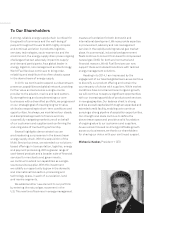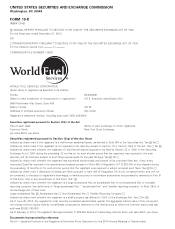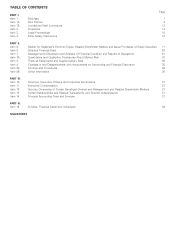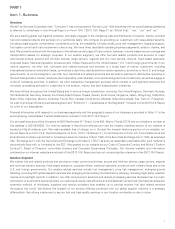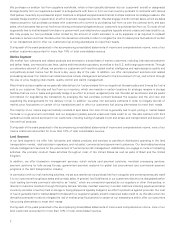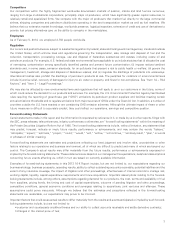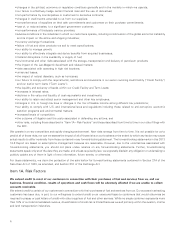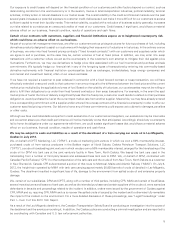World Fuel Services 2013 Annual Report Download - page 9
Download and view the complete annual report
Please find page 9 of the 2013 World Fuel Services annual report below. You can navigate through the pages in the report by either clicking on the pages listed below, or by using the keyword search tool below to find specific information within the annual report.Competitors
Our competitors within the highly fragmented world-wide downstream markets of aviation, marine and land fuel are numerous,
ranging from large multinational corporations, principally major oil producers, which have significantly greater capital resources, to
relatively small and specialized firms. We compete with the major oil producers that market fuel directly to the large commercial
airlines, shipping companies and petroleum distributors operating in the land transportation market as well as fuel resellers. We
believe that our extensive market knowledge, worldwide presence, logistical expertise, extension of credit and use of derivatives to
provide fuel pricing alternatives give us the ability to compete in the marketplace.
Employees
As of February 5, 2014, we employed 2,758 people worldwide.
Regulation
Our current and past activities are subject to substantial regulation by federal, state and local government agencies, inside and outside
the United States, which enforce laws and regulations governing the transportation, sale, storage and disposal of fuel and the
collection, transportation, processing, storage, use and disposal of hazardous substances and wastes, including waste oil and
petroleum products. For example, U.S. federal and state environmental laws applicable to us include statutes that: (i) allocate the cost
of remedying contamination among specifically identified parties and prevent future contamination; (ii) impose national ambient
standards and, in some cases, emission standards, for air pollutants that present a risk to public health or welfare; (iii) govern the
management, treatment, storage and disposal of hazardous wastes; and (iv) regulate the discharge of pollutants into waterways.
International treaties also prohibit the discharge of petroleum products at sea. The penalties for violations of environmental laws
include injunctive relief, recovery of damages for injury to air, water or property, and fines for non-compliance. See ‘‘Item 1A – Risk
Factors,’’ and ‘‘Item 3 – Legal Proceedings.’’
We may also be affected by new environmental laws and regulations that will apply to us or our customers in the future, some of
which could reduce the demand for our products and services. For example, the U.S. Environmental Protection Agency has finalized
rules requiring the reporting of greenhouse gas (‘‘GHG’’) emissions by petroleum product suppliers and facilities meeting certain
annual emissions thresholds and to regulate emissions from major sources of GHGs under the Clean Air Act. In addition, a number of
countries outside the U.S. have enacted or are considering GHG emission schemes. Although the ultimate impact of these or other
future measures is difficult to accurately predict, they could affect our operations, earnings and competitive position.
Forward-Looking Statements
Certain statements made in this report and the information incorporated by reference in it, or made by us in other reports, filings with
the SEC, press releases, teleconferences, industry conferences or otherwise, are ‘‘forward-looking statements’’ within the meaning of
the Private Securities Litigation Reform Act of 1995. The forward-looking statements include, without limitation, any statement that
may predict, forecast, indicate or imply future results, performance or achievements, and may contain the words ‘‘believe,’’
‘‘anticipate,’’ ‘‘expect,’’ ‘‘estimate,’’ ‘‘project,’’ ‘‘could,’’ ‘‘would,’’ ‘‘will,’’ ‘‘will be,’’ ‘‘will continue,’’ ‘‘will likely result,’’ ‘‘plan,’’ or words
or phrases of similar meaning.
Forward-looking statements are estimates and projections reflecting our best judgment and involve risks, uncertainties or other
factors relating to our operations and business environment, all of which are difficult to predict and many of which are beyond our
control. The Company’s actual results may differ materially from the future results, performance or achievements expressed or
implied by the forward-looking statements. These statements are based on our management’s expectations, beliefs and assumptions
concerning future events affecting us, which in turn are based on currently available information.
Examples of forward-looking statements in this 2013 10-K Report include, but are not limited to, our expectations regarding our
business strategy, business prospects, operating results, ability to collect outstanding accounts receivable, potential liabilities and the
extent of any insurance coverage, the impact of litigation and other proceedings, effectiveness of internal controls to manage risk,
working capital, liquidity, capital expenditure requirements and future acquisitions. Important assumptions relating to the forward-
looking statements include, among others, assumptions regarding demand for our products, the cost, terms and availability of fuel
from suppliers, pricing levels, the timing and cost of capital expenditures, outcome of pending litigation and other proceedings,
competitive conditions, general economic conditions and synergies relating to acquisitions, joint ventures and alliances. These
assumptions could prove inaccurate. Although we believe that the estimates and projections reflected in the forward-looking
statements are reasonable, our expectations may prove to be incorrect.
Important factors that could cause actual results to differ materially from the results and events anticipated or implied by such forward-
looking statements include, but are not limited to:
• customer and counterparty creditworthiness and our ability to collect accounts receivable and settle derivative contracts;
• changes in the market price of fuel;
3


